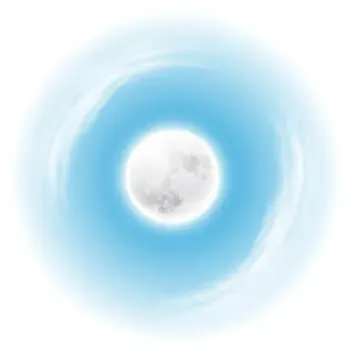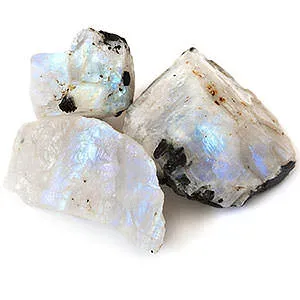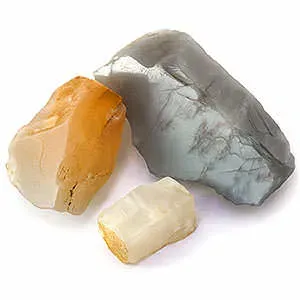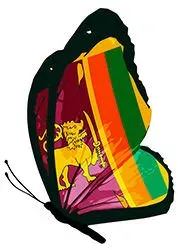 Moonstone is the birthstone for the month of June and the stone traditionally given in celebration of the 13th anniversary of marriage. Moonstone has always been very popular in India. The stone was also prized by the Romans, who thought it was magically formed out of moonlight. Moonstone was used in Roman jewelry since the year 100 AD. Ancient Greeks and Romans both linked the stone with the moon deities. Moonstone comes from the mineral family feldspar, which is one of the most plentiful in the world, however fine gem quality moonstone is scarce and is becoming more scarce as time goes on. Moonstone was very popular in the Art Nouveau jewelry of the early 20th century and continued to flourish until around 1925 in the US. Men wore the stones in stickpins for their ties, in cuff links, rings and mounted as ornaments on watch chains. Women wore moonstones in bracelets, brooches, rings, earrings and necklaces.
Moonstone is the birthstone for the month of June and the stone traditionally given in celebration of the 13th anniversary of marriage. Moonstone has always been very popular in India. The stone was also prized by the Romans, who thought it was magically formed out of moonlight. Moonstone was used in Roman jewelry since the year 100 AD. Ancient Greeks and Romans both linked the stone with the moon deities. Moonstone comes from the mineral family feldspar, which is one of the most plentiful in the world, however fine gem quality moonstone is scarce and is becoming more scarce as time goes on. Moonstone was very popular in the Art Nouveau jewelry of the early 20th century and continued to flourish until around 1925 in the US. Men wore the stones in stickpins for their ties, in cuff links, rings and mounted as ornaments on watch chains. Women wore moonstones in bracelets, brooches, rings, earrings and necklaces.
 Moonstone rates a 6-6.5 on the hardness scale. It is a relatively soft stone but given the proper care, it can last a long time. Moonstone is whitish, gray-white, silvery-white, or milky white with a soft blue shimmer that moves across its face as the stone is moved. This blue moving light is called adularescence. The more shimmer the stone has, the more valuable it is. If the shimmer is of other colors besides blue, the stone is called a "rainbow moonstone". This distinctive and magical shimmer is actually caused by tiny albite inclusions that reflect and scatter light, mimicking the moon's glow, hence the gem's name.
Moonstone rates a 6-6.5 on the hardness scale. It is a relatively soft stone but given the proper care, it can last a long time. Moonstone is whitish, gray-white, silvery-white, or milky white with a soft blue shimmer that moves across its face as the stone is moved. This blue moving light is called adularescence. The more shimmer the stone has, the more valuable it is. If the shimmer is of other colors besides blue, the stone is called a "rainbow moonstone". This distinctive and magical shimmer is actually caused by tiny albite inclusions that reflect and scatter light, mimicking the moon's glow, hence the gem's name.
 Moonstones have always been considered lucky stones and are held in very high esteem in the East. Asians say there is a live spirit in the stone, for as it is turned this way and that, the spirit can be seen moving. Supposedly if one puts a moonstone in his mouth under the light of a full moon, it will foretell whether the owner's love life will be happy or unhappy. A moonstone placed beneath the pillow worn while sleeping was thought to induce dreams of the future and a dream about moonstone has been said to indicate that danger is lurking ahead. There are many beliefs in the power of moonstone to bring about positivity in one's life. The stone is regarded as a great gift for lovers as it supposedly arouses love and passion. It has also been said to cure epilepsy, nervousness, and fever and is believed to ward off cancer, and to protect travelers. Legend holds that if set as a talisman or boiled with lemon juice and other extracts, it can cure anxiety, strengthen resolve, and relieve high blood pressure.
Moonstones have always been considered lucky stones and are held in very high esteem in the East. Asians say there is a live spirit in the stone, for as it is turned this way and that, the spirit can be seen moving. Supposedly if one puts a moonstone in his mouth under the light of a full moon, it will foretell whether the owner's love life will be happy or unhappy. A moonstone placed beneath the pillow worn while sleeping was thought to induce dreams of the future and a dream about moonstone has been said to indicate that danger is lurking ahead. There are many beliefs in the power of moonstone to bring about positivity in one's life. The stone is regarded as a great gift for lovers as it supposedly arouses love and passion. It has also been said to cure epilepsy, nervousness, and fever and is believed to ward off cancer, and to protect travelers. Legend holds that if set as a talisman or boiled with lemon juice and other extracts, it can cure anxiety, strengthen resolve, and relieve high blood pressure.
 Moonstone can be found in Ceylon, India, Burma, Mexico, Norway, Australia, Madagascar, Tanzania, the US, Brazil, and Switzerland. Small stones are not too difficult to find, but large unflawed stones are extremely hard to find. Sri Lanka is the most important source of the gemstone, in terms of volume and quality. Because moonstone is a soft stone, it is fragile and can be easily scratched. Moonstone must be handled with care. The best way to clean it is to rub it lightly with a soft polishing cloth.
Moonstone can be found in Ceylon, India, Burma, Mexico, Norway, Australia, Madagascar, Tanzania, the US, Brazil, and Switzerland. Small stones are not too difficult to find, but large unflawed stones are extremely hard to find. Sri Lanka is the most important source of the gemstone, in terms of volume and quality. Because moonstone is a soft stone, it is fragile and can be easily scratched. Moonstone must be handled with care. The best way to clean it is to rub it lightly with a soft polishing cloth.